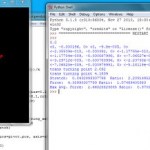Computing
Last week, I spent a bunch of time using VPython to simulate a simple pendulum, which was a fun way to fritter away several hours (yes, I'm a great big nerd), and led to some fun physics. I had a little more time to kill, so I did one of the things I mentioned as a possible follow-on, which turned out to be kind of baffling, in a good way.
Last week's post was written very quickly, and thus ended up a little more jargon-y than I usually shoot for, so let me try to set the stage a little better for this one. the physical system I'm talking about is just a simple pendulum, a mass on the end of…
There's a famous story about Richard Feynman at Cornell suffering from the science equivalent of writer's block, after WWII. He was depressed and feeling like everything he did was pointless, until one day he spotted a student throwing a plate up in the air in the cafeteria. As the plate spun, it wobbled, and the wobble seemed to go faster than the spin. Intrigued, he sat down and calculated the physics involved, finding that, indeed, the wobble should go at twice the rate of spin. This basically reignited his interest in physics, and shortly after that, began his legendarily productive…
In which I steal an analogy from Joe Emerson to explain the limits of quantum computing.
------------
As previously noted, a couple of weeks ago I went to Canada for the opening of the University of Waterloo's new Quantum Nano Center (their photo gallery includes one picture of me being interviewed, along with lots of more interesting pictures from the day). One of my events there was a panel discussion about the new center and what it will mean, which included me, Raymond Laflamme, the director of the Institute for Quantum Computing, and Mike Lazaridis, the founder of Research in Motion, who…
One of physics’ greatest tricks is polarization. Take magnets, for example, such as those commonly found on refrigerators holding up shopping lists and Christmas cards. These have the familiar north/south polarization that we can experience as attraction and repulsion. That magnetic orientation persists all the way down to the individual molecules, which actually align to cause the larger-scale behavior.
This polar phenomenon is caused by ferromagnetism, a defining quality of some particles that gives them an intrinsic polarity – what scientists call a dipole moment. And remarkably, that…
Somebody on Twitter linked this article about "brogrammers", which is pretty much exactly as horrible as that godawful neologism suggests. In between descriptions of some fairly appalling behavior, though, they throw some stats at you, and that's where it gets weird:
As it is, women remain acutely underrepresented in the coding and engineering professions. According to a Bureau of Labor Statistics study, in 2011 just 20 percent of all programmers were women. A smaller percentage of women are earning undergraduate computer science degrees today than they did in 1985, according to the National…
Two things I was forwarded or pointed toward this week, that interact a little oddly. First chronologically is from the New York Times, which has a story about how Harvey Mudd College has boosted the number of female computer science majors, by committing serious resources to reforming the intro course (which is required of all students there):
Known as CS 5, the course focused on hard-core programming, appealing to a particular kind of student -- young men, already seasoned programmers, who dominated the class. This only reinforced the women's sense that computer science was for geeky know-…
We're in the home stretch of this term, and it has become clear that I won't actually be using the toy model of the arrow of time I've talked about in the past in my timekeeping class this term. These things happen. Having spent a not-insignificant amount of time playing with the thing, though, I might as well get a final blog post about it, with something that sort-of worked and something that shows why I'm not a computational physicist:
First, the thing that sort-of worked: in thinking about trying to use the code I wrote, I was struggling to come up with a way to quantify the apparent…
The toy model of statistical entropy that I talked about the other day is the sort of thing that, were I a good computational physicist, I would've banged out very quickly. I'm not a good computational physicist, but by cargo-culting my way through some of the VPython examples, I managed to get something that mostly works:
The graph at the bottom of that window is the entropy versus "time" for a lattice of 20 sites with a 25% hopping probability (either left or right). The window with the colored balls at the upper left is a graphical representation-- red dots are "occupied" sites, white "…
I'm fairly certain somebody has already done this, because it's such an obvious idea. It's a little beyond my cargo-cult VPython skills right at the moment, though (I can probably learn to do it, but not right now), and I none of the applets I Googled up seemed to be doing this, so I'm posting this sketchy description because I've spent some time thinking about it, and might as well get a blog post out of the deal.
So, as we said back in the holiday season, one of the most fundamental concepts in the modern understanding of thermodynamics and statistical physics is the notion of entropy. You…
It's a sign of how good computers have gotten that I'm faintly offended whenever Google Translate fails to come up with something even halfway sensible. I mean, translating a blog post from one language to another is a ridiculously difficult problem, and yet they usually do a passable job. It's only when the vanity search turns up something like this blog post in Hebrew that it fails completely, and gives a string of disconnected and incoherent words and phrases.
So, here's to the amazing successes of Google Translate. And if anybody can tell me what in the world that blog post says about my…
This coming June will mark ten years since I started this blog (using Blogger on our own domain-- here's the very first post) and writing about physics on the Internet. This makes me one of the oldest science bloggers in the modern sense-- Derek Lowe is the only one I know for sure has been doing this longer than I have, and while Bob Park's "What's New" and John Baez's "This Week's Finds" have been around longer, they started out as mailing lists, not true weblogs.
As such a long-term denizen of the Internet, I'm pretty much contractually obliged to have an opinion about Michael Nielsen's…
(This post is part of the new round of interviews of non-academic scientists, giving the responses of Adam DeConinck, who works at a company providing supercomputing resources. The goal is to provide some additional information for science students thinking about their fiuture careers, describing options beyond the assumed default Ph.D.--post-doc--academic-job track.)
1) What is your non-academic job?
I work as a systems engineer at R Systems, a company that provides high-performance computing (HPC) resources to the commercial and academic research communities. We own and operate a number of…
There's a new physics Q&A site from the folks at Stack Exchange, this one on physics. If you're not familiar with the format, it's a bulletin-board style site where you can post questions to be answered by other users, and people vote the answers up and down, so you can get a decent feel for which answers are good, and which are less useful.
There's a pretty wide range of questions, covering everything from really basic concepts to fairly technical questions about current research. My own feeling about this is that if you're going to have it on the public web, you ought to expect and be…
the hot topic in mathematical sciences at the moment is the draft proof that P≠NP (warning: PDF). This is one of the biggest issues in computer science, and one of the Clay Mathematics Institute's Millennium Problems, so a proof would be Big News in math/CS, and earn the prover a cool $1,000,000. Reaction among blogging theorists is mixed, with some intrigued and at least one willing to bet against it.
So what do I think of the proof? Honestly, this is so far out of my areas of competence that I need Google to remind me what the symbols mean. About all I know is that it's a Big Deal in…
Inside Higher Ed featured one of those every-so-often articles about the awesomeness of the demographic subgroup of the moment, this time Athur Levine's panegyric about "digital natives", who "grew up in a world of computers, Internet, cell phones, MP3 players, and social networking," and how they're too cool and tech-savvy for current universities:
They differ from their colleges on matters as fundamental as how they conceive of and utilize physical plant and time. For the most part, universities operate in fixed locales, campuses, and on fixed calendars, semesters and quarters with classes…
Wow, this is a very cool result:
Researchers at IBM's Thomas J. Watson Research Center in Yorkstown, NY have announced a breakthrough which they feel could revolutionize power consumption in computers. Today's computers are power hungry: a typical computer consumes hundreds of watts of power. Not only does this power consumption add up to a lot of wasted power, but increasingly the amount of heat generated by the machines is a significant barrier to building faster more powerful computers. The researchers at IBM say they've made a breakthrough in how computers consume power which will…
Just in time for Women's History Month and the second edition of the Diversity in Science Carnival, the Association for Computing Machinery has announced that the 2008 Turing Award goes to Barbara Liskov! Here's all the info from the press release:
ACM, the Association for Computing Machinery, has named Barbara Liskov of the Massachusetts Institute of Technology (MIT) the winner of the 2008 ACM A.M. Turing Award. The award cites Liskov for her foundational innovations to designing and building the pervasive computer system designs that power daily life. Her achievements in programming…



